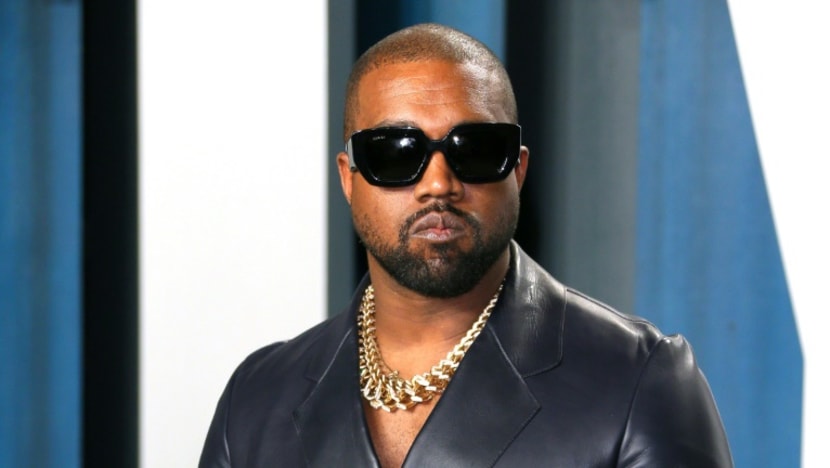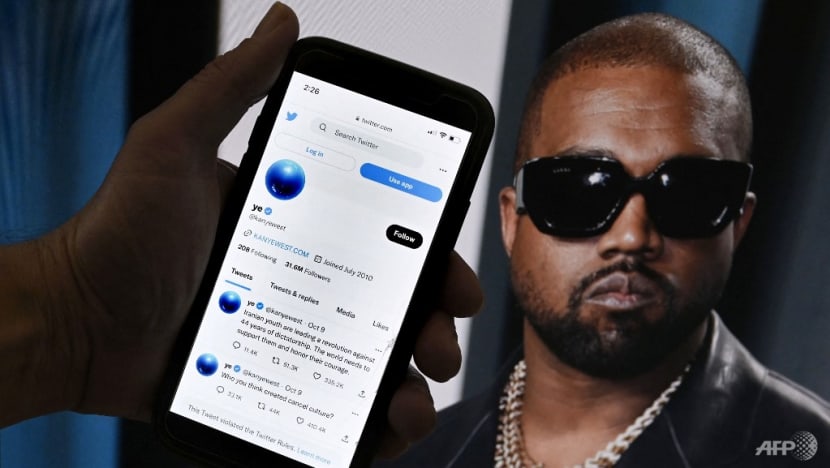Commentary: Kanye West is making us take Adolf Hitler seriously in all the wrong ways
"Hitler kitsch", "Nazi porn" and Godwin’s Law have given us the frightening ignorance of people like Kanye West, says Bloomberg Opinion's Andreas Kluth.

Kanye West, pictured in 2020, has seen his commercial relationships crumble after a series of anti-Semitic comments. (File photo: AFP/Jean-Baptiste Lacroix)
BERLIN: We could try to just dismiss people such as Ye, the celebrity formerly known as Kanye West, as unhinged.
After all, American talk shows - like the one on which Ye slavered his latest drivel from underneath the black ski mask he was wearing - teem with bigoted twaddle. Nobody takes that stuff seriously, right?
But ask yourself how one of the few remaining Holocaust survivors would hear the words Ye uttered. Or, for that matter, how one of the many Holocaust deniers will now use them. No, we can’t just call Ye and his ilk deranged and move on. We’ve got a problem.
Ye’s topic was Adolf Hitler. The rapper apparently sees the Fuehrer as yet another right-wing victim of the woke and lamestream media’s fake news.
“Every human being has something of value that they brought to the table, especially Hitler,” Ye insisted. "There's a lot of things that I love about Hitler, a lot of things." He clarified: “I am a Nazi." More generally, Ye added, "we got to stop dissing the Nazis all the time".

THE DANGERS OF IGNORANCE
A few days earlier, Ye and another anti-Semitic Holocaust denier, Nick Fuentes, had dined with Donald Trump at the former US president’s resort in Florida.
But it’s not only the odious bully pulpit that comes with celebrity that makes these haters dangerous. It’s the way they simultaneously propagate and embody a pre-existing trend toward general ignorance and bad faith, the preconditions for a resurgence in anti-Semitism, racism and hate.
The ignorance alone is staggering. In the US, according to a survey, 63 per cent of young adults don’t know that 6 million Jews were murdered in the Nazi Holocaust, and 36 per cent think the number was “2 million or fewer.”
About one in 10 isn’t sure whether the Shoah happened at all or denies that it did. Perhaps most shockingly, 19 per cent of Millennials and Zoomers in New York State believe that it was the Jews who caused the Holocaust.
How did we get to this point? Within the lifetime of a Holocaust survivor, many Western societies went from seeing Hitler as the worst embodiment of evil in human history - and an exhortation never to let genocide happen again - to just another meme to be exploited in our social media and petty political skirmishes.
Part of the answer has to do with a phenomenon the Germans, who should know something about the matter, call “Nazi porn” or “Hitler kitsch". It’s a trend I’ve been watching with concern for years.
The 1960s and 70s were decades when the general public in most countries learned the full extent of the Holocaust and therefore held its remembrance in awe. It began during the 1960s with high-profile Nazi trials in Jerusalem and Frankfurt that exposed the genocide in new detail and famously inspired the philosopher Hannah Arendt to opine on the “banality of evil".
It continued with ground-breaking biographies of Hitler in the 1970s and the American TV series Holocaust, which also jolted Germans into a new and harrowing round of soul-searching. This line of documenting and commemorating the Shoah continues.
RAW MATERIAL FOR MEMES
Starting in the 1980s, however, another media phenomenon developed in parallel. It began when Stern, a German magazine, published what it alleged was Hitler’s diary. It was a sensation - and also turned out to be fake.
A worrying precedent was set: The Fuehrer as clickbait to sell copies and, nowadays, to harvest retweets. The fascination with the Nazis became prurient. German television, as I’ve written before, airs almost nightly documentaries on Hitler’s henchmen, women, ailments, table silver or German Shepherd Blondi.
Increasingly, the obsession veered off into parody. It was one thing for Charlie Chaplin, during Hitler’s lifetime, to ridicule the enemy in The Great Dictator. It was quite another in 1998 for Walter Moers, a German satirist, to score a hit with a comic strip called “Adolf, the Nazi pig".
That launched a genre of Hitler farce, including bestsellers such as Look Who’s Back. In that novel, the Fuehrer wakes up near his old bunker in present-day Berlin and so amuses people with his shtick that he kills it as a comedian.
The phenomenon isn’t German but global. Hitler has become the raw material for memes. For example, there’s that scene in Downfall in which the dictator, played by Bruno Ganz, loses it.
The clip keeps circling around the world, each time with new captions. Here the Fuehrer can’t find his favourite cupcakes on either the Upper East Side or the Upper West. Here he’s stuck with Bitcoin when he should have invested in Dogecoin.
Pundits and the public keep invoking Hitler’s name in vain. As early as 1990, Mike Godwin, an American lawyer and author, coined “Godwin’s Law” of Nazi analogies. It states that as an online discussion grows longer - regardless of the topic - the probability of a comparison to Adolf Hitler approaches 1. For corroboration, just look at the comment sections under some of my columns.
We hardly batted an eyelid anymore when Prince Harry showed up at a party dressed in Brown Shirt and Swastika. I once heard an Iyengar teacher who was rather too precise about asana alignment described as, yes, a "yoga Nazi".
The phenomenon amounts to a reverse Voldemort effect. In the Harry Potter novels, the personification of evil commanded such revulsion and awe that witches, wizards and warlocks referred to him only as “He Who Must Not Be Named” or “You-Know-Who.”
With Hitler, it’s the opposite: The Fuehrer is He Who Must Be Named All the Time, Whether It Fits or Not. As a result, he no longer seems evil, just cartoonish.
MORAL VOID
What began funny (to some) has become perverse. It’s unbearable to watch Russian President Vladimir Putin hop on the meme bandwagon while simultaneously adopting Hitler’s own propaganda style - by reversing the roles of victims and perpetrators, for example.
Thus Putin would have you believe that it’s the Ukrainians who are Nazis, and that he’s defending Russians from them. Confronted by the cognitive dissonance that Ukrainian President Volodymyr Zelenskyy is Jewish, Russian Foreign Minister Sergey Lavrov has mused that "Adolf Hitler had Jewish blood too".
So here we are, with everyone from rappers in ski masks to genocidal autocrats holding forth about Hitler and the Nazis, unburdened by fact, proportion or decency. And the rest of us, especially Millennials and Zoomers, are left groping through a postmodern fog, where nothing is true and everything is possible - and, when in doubt, hilarious.
This is the moral void we used to fear, the intellectual vacuum where hatred grows and eventually makes mass murder imaginable once again. The problem’s not just Kanye West. All of us have dumbed down memory to the point of nihilism.

















